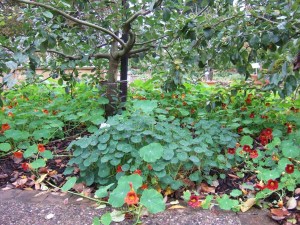Climate-friendly plants
‘Climate-friendly plants’ – are there any such things? Well no, all plants absorb carbon dioxide, but some plants are more climate-friendly than others, and it’s what we do with them that counts.
If we make an orchard garden with many layers then we can increase the garden’s productivity and absorb more carbon dioxide.
Trees, hedges and shrubs are beautiful, give our gardens structure, provide food and shelter for wild animals, and shelter our gardens from the drying effects of wind and sun, and so help to keep soil moist and rich in carbon.
If we grow mostly perennial plants rather than annuals, and if we grow ground-cover plants, then we’ll protect the carbon in the soil and stop it being oxidised by cultivation. If we do grow annuals, for example in vegetable plots, then we can make sure we keep the ground covered with mulch or with green manure plants.
We may want to save on the fossil-fuel impact of mowing, but lawns are also good for people to enjoy, for wild animals to find food in, and to store carbon, so we can still include grassland if we include nitrogen-fixing plants such as clovers, keep our lawns small, and mow them with hand-powered mowers, electric mowers powered by renewables, or mulching mowers, or keep most of them as meadows cut only once or twice a year.
Almost any water in a garden makes it feel more peaceful. Rain gardens can help to collect rain and return it to the groundwater. Ponds and boggy patches are great for wildlife, and store carbon in the sediments produced by water plants. We need to include oxgenating plants in the water to keep it oxidated and reduce the risk of methane being produced from anaerobic sediments.
Climbers, like trees, shrubs and hedges, can insulate our homes and reduce the fossil-fuel impact of heating or air conditioning.
So in our climate-friendly garden we can include:
- trees
- shrubs and hedges
- herbaceous perennials, and only a few annuals and biennials
- ground-cover plants
- lawn and meadow plants in small areas
- pond, wetland and rain garden plants
- climbers.
We can also consider other things that make any of these plants more climate-friendly:
- soil protection;
- feeding soil with carbon and nitrogen, such as nitrogen-fixing plants, deep-rooted plants, and plants with good root systems;
- long life, which means more carbon dioxide absorbed and more soil carbon created;
- resilience in different conditions, especially water-thriftiness;
- usefulness – food plants, craft plants, medicinal plants;
- vigorous growth.
We can also consider other criteria which apply in all gardens:
- beauty, whatever form it takes in our beholder’s eyes;
- plants as wildlife and for wildlife;
- companion plants which benefit the plants around them;
- right plant, right place – choosing plants which fit the garden’s conditions.
And of course just because a plant might not meet these criteria, that doesn’t mean we exclude it from our gardens – just make sure it’s balanced by lots of climate-friendly plants.
But we need to avoid plants with some characteristics which would be bad for climate:
- avoid fire-prone plants;
- avoid thirsty plants which cannot survive without added tapwater;
- avoid plants which inhibit other plants.
We also need to avoid plants which would cause other problems:
- avoid invasive plants, and plants which are considered likely to become invasive.
There’s information on invasive and potentially invasive species from the GB non-native species secretariat.

